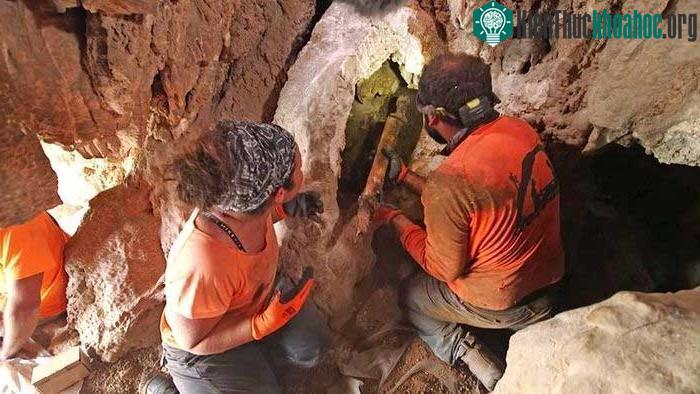The arsenal was found after scientists from Ariel University, the Hebrew University of Jerusalem and the Israel Antiquities Authority (IAA) returned to the cave to study a stalactite bearing ancient Hebrew inscriptions. , where they found a number of related artifacts.
According to an IAA announcement released on September 6, the rare “arsenal” was found in a cave in the En Gedi Nature Reserve in the Judean desert, spreading across parts of the West Bank and Israel today.

The swords were found in a cave in the En Gedi Nature Reserve, Israel.
The swords were found in a cave in the En Gedi Nature Reserve, Israel. (Photo: Emil Aladjem/IAA).Cave at the archaeological site overlooking the Dead Sea
According to the announcement, 4 swords were found in an almost inaccessible crevice in the upper level of the cave.

They are exceptionally well preserved, found with hilts and scabbards made of leather, wood or metal. Of which 3 swords are Roman spatha swords, with blades 60-65 cm long, the fourth has a shorter, round hilt, 45 cm long.
“This is an impressive and exciting discovery, touching on a specific historical moment,” said IAA Director Eli Escusido.
According to researchers, these weapons may be war spoils from the Roman army when the Roman Empire occupied the Judean region.
Scientists were surprised by the artifacts found.

The swords are hidden in a deep crevice in the upper level of the cave.
The swords are hidden in a deep crevice in the upper level of the cave. (Photo: Emil Aladjem/IAA).“The hiding of the swords in the depths of an isolated cave north of En Gedi suggests that these weapons may have been spoils of war from Roman soldiers or from the battlefield, hidden by Judean rebels for use,” said Eitan Klein, Director of the Judean Desert Survey Project, describing this as an extremely rare historical find, as similar things have never been found in Israel.
After discovering the swords, archaeologists conducted extensive excavations in the cave, discovering artifacts from the Paleolithic period (about 6,000 years ago) and the Roman period (about 2,000 years ago). . 000 years ago).

The swords are well preserved, including the scabbard.
The swords are well preserved, including the scabbard. (Photo: Dafna Gazit/IAA).Artifacts are on display.
Artifacts on display. (Photo: Yoli Schwartz/IAA).At the entrance to the cave, researchers found a bronze Bar Kochba coin dating from 132 – 135 AD, a date determined to also be the date of the swords.
This time coincided with the period of the Bar Kochba rebellion of Jews against Roman rule in Judean, led by rebel leader Simon Bar Kochba.

Scientists were surprised to discover the “arsenal”.
The cave survey began in 2017 and helped researchers discover at least 20 new caves that were previously unknown.

In 2021, archaeologists announced that one of the caves contained pieces of previously undiscovered rocks.